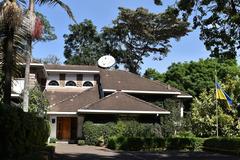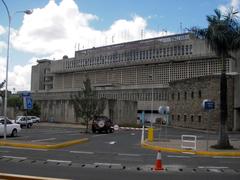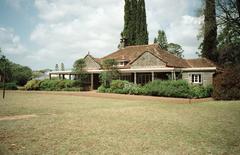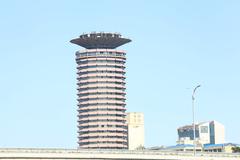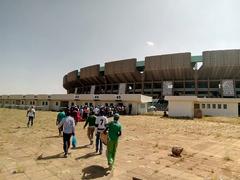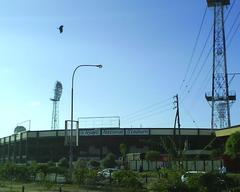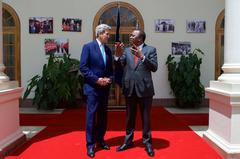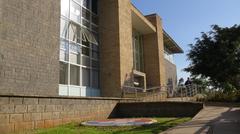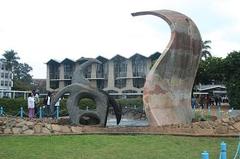Guide to Visiting Nairobi Gallery Nairobi Kenya
Date: 24/07/2024
Introduction
The Nairobi Gallery is a treasure trove of Kenyan history, art, and culture. Located at the intersection of Kenyatta Avenue and Uhuru Highway, this gallery is housed in a historic building originally constructed in 1913. Over the years, it has served various roles, from the Ministry of Native Affairs during the colonial period to the office of the Provincial Commissioner post-independence. Today, it stands as a national monument and a vibrant cultural hub. The Nairobi Gallery offers visitors a unique glimpse into Kenya’s past and present through its diverse art collections, including the renowned Murumbi African Heritage Collection, and its meticulously preserved Victorian architecture (TourTravelWorld) (museums.or.ke) (safari254.com).
Table of Contents
- [Discover Nairobi Gallery](#discover-nairobi-gallerydiscover-nairobi-gallery)
- [History of Nairobi Gallery](#history-of-nairobi-galleryhistory-of-nairobi-gallery)
- [Colonial Beginnings](#colonial-beginningscolonial-beginnings)
- [“Hatches, Matches, and Dispatches”](#hatches-matches-and-dispatcheshatches-matches-and-dispatches)
- [Post-Independence Use](#post-independence-usepost-independence-use)
- [National Monument Status](#national-monument-statusnational-monument-status)
- [Renovation and Opening](#renovation-and-openingrenovation-and-opening)
- [Joseph and Sheila Murumbi Collections](#joseph-and-sheila-murumbi-collectionsjoseph-and-sheila-murumbi-collections)
- [Architectural Significance](#architectural-significancearchitectural-significance)
- [Point Zero](#point-zeropoint-zero)
- [Colonial Safes](#colonial-safescolonial-safes)
- [Temporary Exhibitions and Local Artists](#temporary-exhibitions-and-local-artiststemporary-exhibitions-and-local-artists)
- [Digitalization and Modernization](#digitalization-and-modernizationdigitalization-and-modernization)
- [Visitor Information](#visitor-informationvisitor-information)
- [Visiting Hours](#visiting-hoursvisiting-hours)
- [Ticket Prices](#ticket-pricesticket-prices)
- [Accessibility](#accessibilityaccessibility)
- [Travel Tips](#travel-tipstravel-tips)
- [Nearby Attractions](#nearby-attractionsnearby-attractions)
- [FAQ](#faqfaq)
- [History of Nairobi Gallery](#history-of-nairobi-galleryhistory-of-nairobi-gallery)
Discover Nairobi Gallery
History of Nairobi Gallery
Colonial Beginnings
The Nairobi Gallery, located at the intersection of Kenyatta Avenue and Uhuru Highway, is a significant historical and cultural landmark in Nairobi, Kenya. The building was constructed in 1913 and originally served as the Ministry of Native Affairs during the colonial era. Designed by C. Rand Ovary, the structure is an excellent example of Victorian architecture, featuring columns, niches, friezes, and pediments made of natural stone (museums.or.ke).
”Hatches, Matches, and Dispatches”
During its early years, the building was colloquially known as “Hatches, Matches, and Dispatches” due to its role in recording births, marriages, and deaths. This nickname reflects the building’s central role in the lives of Nairobi’s residents during the colonial period. It also functioned as a courthouse where natives accused of entering Nairobi without a pass were tried and sentenced (safari254.com).
Post-Independence Use
After Kenya gained independence in 1963, the building was repurposed as the office of the Provincial Commissioner of Nairobi until 1984. Subsequently, it served as the Nairobi branch office for the Kenya African National Union (KANU), the ruling party at the time, until 1997 (wikipedia.org).
National Monument Status
Recognizing its historical significance, the Kenyan government declared the building a national monument in 1995. This designation was formalized through Gazette Notices 5257 and 2016, issued in 1993 and 1995, respectively. The building was then handed over to the National Museums of Kenya for preservation and renovation (museums.or.ke).
Renovation and Opening
The National Museums of Kenya began renovating the building in 1999, a process that was completed in 2005. The gallery officially opened to the public in November 2005 with its first temporary exhibition, “Dreaming in Pictures” by Jak Katarikawe (wikipedia.org).
Joseph and Sheila Murumbi Collections
One of the key attractions of the Nairobi Gallery is the Murumbi African Heritage Collection. Joseph Murumbi, Kenya’s second Vice-President, and his wife Sheila were avid collectors of African art and artifacts. Their collection includes a wide range of items from various African countries, making the gallery a treasure trove of African heritage (safari254.com).
Architectural Significance
The Nairobi Gallery is an architectural gem, showcasing Victorian design elements. The building’s exterior is adorned with columns, niches, friezes, and pediments, while the interior features an octagonal dome hall known as Point Zero. This central space is surrounded by rooms extending into two wings, with walls finished in smooth plaster and windows and doors made of teak wood (museums.or.ke).
Point Zero
Point Zero is a unique feature of the Nairobi Gallery. It is the exact spot from which all distances in Kenya were historically measured. The black spot at the center of the octagonal dome hall marks this point, making it a significant landmark for both historical and educational purposes (artsandculture.google.com).
Colonial Safes
The gallery also houses two old safes that were used by the colonial government. These safes have never been opened since the colonial era, adding an element of mystery and historical intrigue to the gallery (museums.or.ke).
Temporary Exhibitions and Local Artists
In addition to the permanent Murumbi collection, the Nairobi Gallery hosts temporary art exhibitions every three months. These exhibitions feature works by both pioneer and upcoming artists from Kenya and other African countries. Notable artists whose works have been displayed include Magdalene Odondo, Expendito Mwembe Kibula, and Elkana Ongesa (museums.or.ke).
Digitalization and Modernization
In 2019, the National Museums of Kenya collaborated with Google to digitize the Nairobi Gallery’s exhibits. This initiative included adding an adapted version of Google Street View to the museum’s rooms, making the gallery’s collections accessible to a global audience (wikipedia.org).
Visitor Information
Visiting Hours
The Nairobi Gallery is open to visitors from Monday to Sunday, 8:30 AM to 5:30 PM. It is advisable to check their official website for any changes in opening hours or special holiday schedules.
Ticket Prices
The entrance fee for the Nairobi Gallery is as follows:
- Residents: Ksh 150 for adults, Ksh 100 for children
- Non-residents: USD 10 for adults, USD 5 for children
Discounts may be available for group bookings, so it is worth inquiring in advance.
Accessibility
The Nairobi Gallery is committed to being accessible to all visitors. The building is equipped with ramps and accessible restrooms to accommodate visitors with disabilities. Guided tours are also available upon request to enhance the visitor experience.
Travel Tips
- Best Time to Visit: Weekdays are generally less crowded than weekends.
- Getting There: The gallery is centrally located and can be easily accessed via public transportation or taxi services.
- Nearby Amenities: There are several cafes and restaurants within walking distance where visitors can enjoy a meal or refreshments after their tour.
Nearby Attractions
Visitors to the Nairobi Gallery can also explore several other nearby attractions:
- Nairobi National Museum: Offers a comprehensive overview of Kenya’s cultural and natural history.
- Kenya National Archives: Home to a vast collection of historical documents and artifacts.
- Uhuru Park: A large recreational park perfect for relaxation and picnics.
- Kenyatta International Conference Centre: Known for its iconic tower and panoramic views of Nairobi.
Conclusion
The Nairobi Gallery stands as a testament to Kenya’s rich history and cultural heritage. From its colonial beginnings to its current role as a museum and national monument, the gallery offers visitors a unique glimpse into the past while celebrating the vibrant art and culture of Africa. Whether you are a history buff, an art enthusiast, or simply a curious traveler, the Nairobi Gallery promises a memorable and enriching experience.
FAQ
What are the visiting hours of Nairobi Gallery?
The Nairobi Gallery is open from Monday to Sunday, 8:30 AM to 5:30 PM.
How much does it cost to visit Nairobi Gallery?
The entrance fee is Ksh 150 for resident adults, Ksh 100 for resident children, USD 10 for non-resident adults, and USD 5 for non-resident children.
Call to Action
Planning a visit to Nairobi? Don’t miss out on the Nairobi Gallery. For more information on Nairobi’s historical sites, download our mobile app Audiala, check out other related posts, and follow us on social media for the latest updates.
References
- TourTravelWorld. Nairobi Gallery. Retrieved from https://www.tourtravelworld.com/kenya/nairobi/nairobi-gallery.htm
- National Museums of Kenya. Nairobi Gallery. Retrieved from https://museums.or.ke/nairobi-gallery/
- Safari254.com. Nairobi Gallery - A Combination of Art and History. Retrieved from https://www.safari254.com/nairobi-gallery-combination-art-history/
- Google Arts & Culture. Take a tour of the Nairobi Gallery - National Museums of Kenya. Retrieved from https://artsandculture.google.com/story/take-a-tour-of-the-nairobi-gallery-national-museums-of-kenya/jAURoZIlsJNBKg?hl=en
